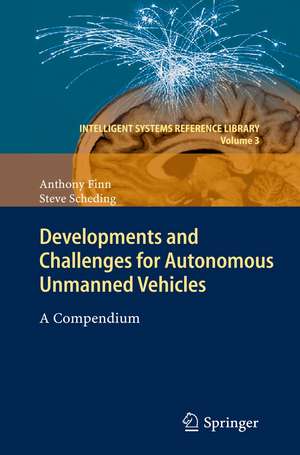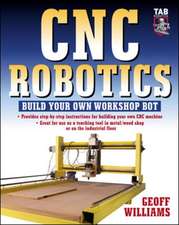Developments and Challenges for Autonomous Unmanned Vehicles: A Compendium: Intelligent Systems Reference Library, cartea 3
Autor Anthony Finn, Steve Schedingen Limba Engleză Paperback – 4 mai 2012
The book draws upon a broad range of others’ work with a view to providing a product that is greater than the sum of its parts. The discussion is intentionally approached from the perspective of improving understanding rather than providing solutions or drawing firm conclusions. Consequently, researchers reading this book with the hope of uncovering some novel theory or approach to automating an unmanned vehicle will be as disappointed as the capability planner who anticipates a catalogue of technical risks and feasibility options against his favoured list of component technologies and potential applications. Nevertheless, it is hoped that both will at least learn something of the other’s world and that progress will ensue as a result.
For the defence policy and decision maker, this is a "must-read" book which brings together an important technology summary with a considered analysis of future doctrinal, legal and ethical issues in unmanned and autonomous systems. For research engineers and developers of robotics, this book provides a unique perspective on the implications and consequences of our craft; connecting what we do to the deployment and use of the technology in current and future defence systems.
Professor Hugh Durrant-Whyte
| Toate formatele și edițiile | Preț | Express |
|---|---|---|
| Paperback (1) | 643.50 lei 6-8 săpt. | |
| Springer Berlin, Heidelberg – 4 mai 2012 | 643.50 lei 6-8 săpt. | |
| Hardback (1) | 647.61 lei 6-8 săpt. | |
| Springer Berlin, Heidelberg – 28 feb 2010 | 647.61 lei 6-8 săpt. |
Din seria Intelligent Systems Reference Library
- 20%
 Preț: 1050.59 lei
Preț: 1050.59 lei - 20%
 Preț: 1157.60 lei
Preț: 1157.60 lei - 20%
 Preț: 648.44 lei
Preț: 648.44 lei - 20%
 Preț: 650.08 lei
Preț: 650.08 lei - 20%
 Preț: 1005.64 lei
Preț: 1005.64 lei - 5%
 Preț: 968.90 lei
Preț: 968.90 lei - 20%
 Preț: 1052.67 lei
Preț: 1052.67 lei - 20%
 Preț: 1171.46 lei
Preț: 1171.46 lei - 20%
 Preț: 1164.84 lei
Preț: 1164.84 lei - 20%
 Preț: 815.84 lei
Preț: 815.84 lei - 20%
 Preț: 989.96 lei
Preț: 989.96 lei - 20%
 Preț: 1063.41 lei
Preț: 1063.41 lei - 20%
 Preț: 925.45 lei
Preț: 925.45 lei - 20%
 Preț: 504.38 lei
Preț: 504.38 lei - 18%
 Preț: 1113.26 lei
Preț: 1113.26 lei - 20%
 Preț: 1920.04 lei
Preț: 1920.04 lei - 20%
 Preț: 990.62 lei
Preț: 990.62 lei - 20%
 Preț: 651.57 lei
Preț: 651.57 lei - 20%
 Preț: 645.97 lei
Preț: 645.97 lei - 20%
 Preț: 660.16 lei
Preț: 660.16 lei - 20%
 Preț: 647.13 lei
Preț: 647.13 lei - 20%
 Preț: 654.05 lei
Preț: 654.05 lei - 20%
 Preț: 649.93 lei
Preț: 649.93 lei - 20%
 Preț: 648.11 lei
Preț: 648.11 lei - 20%
 Preț: 657.99 lei
Preț: 657.99 lei - 20%
 Preț: 656.84 lei
Preț: 656.84 lei - 20%
 Preț: 1624.04 lei
Preț: 1624.04 lei - 20%
 Preț: 642.98 lei
Preț: 642.98 lei - 20%
 Preț: 649.60 lei
Preț: 649.60 lei - 20%
 Preț: 651.23 lei
Preț: 651.23 lei - 20%
 Preț: 653.06 lei
Preț: 653.06 lei - 20%
 Preț: 1002.99 lei
Preț: 1002.99 lei - 20%
 Preț: 645.14 lei
Preț: 645.14 lei - 20%
 Preț: 658.33 lei
Preț: 658.33 lei - 20%
 Preț: 644.98 lei
Preț: 644.98 lei - 20%
 Preț: 646.62 lei
Preț: 646.62 lei
Preț: 643.50 lei
Preț vechi: 804.37 lei
-20% Nou
Puncte Express: 965
Preț estimativ în valută:
123.15€ • 128.09$ • 101.67£
123.15€ • 128.09$ • 101.67£
Carte tipărită la comandă
Livrare economică 14-28 aprilie
Preluare comenzi: 021 569.72.76
Specificații
ISBN-13: 9783642262708
ISBN-10: 3642262708
Pagini: 248
Ilustrații: 230 p. 20 illus.
Dimensiuni: 155 x 235 x 13 mm
Greutate: 0.36 kg
Ediția:2010
Editura: Springer Berlin, Heidelberg
Colecția Springer
Seria Intelligent Systems Reference Library
Locul publicării:Berlin, Heidelberg, Germany
ISBN-10: 3642262708
Pagini: 248
Ilustrații: 230 p. 20 illus.
Dimensiuni: 155 x 235 x 13 mm
Greutate: 0.36 kg
Ediția:2010
Editura: Springer Berlin, Heidelberg
Colecția Springer
Seria Intelligent Systems Reference Library
Locul publicării:Berlin, Heidelberg, Germany
Public țintă
ResearchCuprins
Background.- Autonomous UVS.- UVS Technology Issues.- Force-Integration of UVS.- Legal Issues for UVS.
Textul de pe ultima copertă
It is widely anticipated that autonomous vehicles will have a transformational impact on military forces and will play a key role in many future force structures. As a result, many tasks have already been identified that unmanned systems could undertake more readily than humans. However, for this to occur, such systems will need to be agile, versatile, persistent, reliable, survivable and lethal. This will require many of the vehicles ‘cognitive’ or higher order functions to be more fully developed, whereas to date only the ‘component’ or physical functions have been successfully automated and deployed.
The book draws upon a broad range of others’ work with a view to providing a product that is greater than the sum of its parts. The discussion is intentionally approached from the perspective of improving understanding rather than providing solutions or drawing firm conclusions. Consequently, researchers reading this book with the hope of uncovering some novel theory or approach to automating an unmanned vehicle will be as disappointed as the capability planner who anticipates a catalogue of technical risks and feasibility options against his favoured list of component technologies and potential applications. Nevertheless, it is hoped that both will at least learn something of the other’s world and that progress will ensue as a result.
For the defence policy and decision maker, this is a "must-read" book which brings together an important technology summary with a considered analysis of future doctrinal, legal and ethical issues in unmanned and autonomous systems. For research engineers and developers of robotics, this book provides a unique perspective on the implications and consequences of our craft; connecting what we do to the deployment and use of the technology in current and future defence systems.
Professor Hugh Durrant-Whyte
The book draws upon a broad range of others’ work with a view to providing a product that is greater than the sum of its parts. The discussion is intentionally approached from the perspective of improving understanding rather than providing solutions or drawing firm conclusions. Consequently, researchers reading this book with the hope of uncovering some novel theory or approach to automating an unmanned vehicle will be as disappointed as the capability planner who anticipates a catalogue of technical risks and feasibility options against his favoured list of component technologies and potential applications. Nevertheless, it is hoped that both will at least learn something of the other’s world and that progress will ensue as a result.
For the defence policy and decision maker, this is a "must-read" book which brings together an important technology summary with a considered analysis of future doctrinal, legal and ethical issues in unmanned and autonomous systems. For research engineers and developers of robotics, this book provides a unique perspective on the implications and consequences of our craft; connecting what we do to the deployment and use of the technology in current and future defence systems.
Professor Hugh Durrant-Whyte
Caracteristici
covering all recent topics on Autonomous Unmanned Vehicles present the Developments and Challenges for Autonomous Unmanned Vehicles in a well organized style









